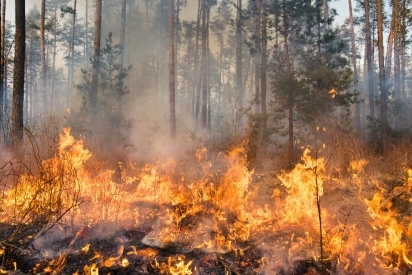Global change and mega-fires
Inazio Martínez de Arano: "There is no forest policy that offers fire management strategies from a holistic point of view".

In the cycle of conferences organized by the Donostia Sustainability Forum of the UPV, a highly topical issue has been addressed by the expert Inazio Martínez de Arano: forest fires and how the climatic emergency affects them. Above all, Martínez de Arano has analysed in his speech the problem of very large fires and the behaviour that this requires.
The researcher Inazio Martínez de Arano works at the European Forest Institute (EFI). He knows the situations in many European and non-European countries, among other things because he has been doing research in the forestry area at the Australian University of Chile for years. He has also worked as a freelance researcher and has known the subject of forest management from the inside. His speciality lies in the relationship between science and innovation in forestry.
The talk started with data on fires and forests. Europe has a structural problem of forest fires. In four southern countries, Portugal, Spain, Italy and Greece, the problem has persisted and every year some 400,000 hectares are burned, an amount that does not diminish over time.
The numbers are very high, but not all fires are the same. Most fires do not last, as firefighting capacity is enormous, says Martínez de Arano. Most are put out in the first few minutes. But those few that escape us are the problem. In Europe, 2% of fires burn 80% of the surface area.
While 30-40 years ago, large fires happened occasionally, now they have multiplied. As an example, Martínez de Arano recalled a big fire in the Basque Country in 1989, when 30,000 hectares burned in 5 days. These are fires that did not occur frequently but in the last decades, there is one almost every year and some of them have been very violent.
In any case, from this point of view, they can be considered a natural system of ecosystem renewal. Martínez de Arano pointed out that in Siberia these fires are not extinguished if a house is not reached. In southern Europe, on the other hand, we base our fire-fighting activities on extinguishing fires.
And although it may seem a paradox, today forests and tree plantations have taken up more area than ever before. Forests now account for 43% of Europe's territory. As seen from the point of view of climate emergency, these forests absorbs 13% of emissions. "Forest expansion in Europe is very fast and very violent," says Martínez de Arano. "And it is not a question of plantations, but it usually involves the regeneration of natural forests, due to the failure of the rural economy. As a result, the forest is very young, with a very adequate fire structure and without great economic value".
This is one of the causes of the problem of giant fires because the amount of biomass that can be burned is very high. Also, a large proportion of the territory being forest, the border between the forest and urban areas is also very high. When a large fire spreads, it easily reaches an environment inhabited by many people.
"When we look at a forest, each person sees his or her own thing" says Martínez de Arano. An ecologist sees ecosystems, foresters see timber, livestock farmers see the grass in the pastures and a firefighter sees fuel.
Martínez de Arano has used the idea of global change instead of just talking about climate change because the climate has been accompanied by many changes. For example, globalization and urbanization have changed, and the tertiary sector has increased a lot. "It's not an ecological problem, it's a social and economic problem," he says. The risk of large fires is increasing and the time of year is extending. Droughts are longer and rainfall is more intense. All this has led to extreme conditions, including the proliferation of fires.
Not much research has been done on why fires are lit. "We usually put in moral factors," says the speaker. “We look for the type of fault: accident, casualty or negligence. But we don't look at the underlying sociological problems”.
"It is clear that we are reaching the limit of strategies based on merely extinguishing fires," says Martínez de Arano. On the one hand, because of their limited effectiveness against extreme fires and, on the other, because of their high economic cost. Over time, fire extinction is being increasingly managed from a civil protection perspective in many countries. There are many related lobbies and, consequently, a great fragmentation of policy and information and, for instance, we do not know how much Europe spends on fire management. In any case, what is invested in fireproofing resources is lost in the forest management budget. In the United States, for example, 40% of the forestry budget is invested in fire protection policies. In Europe, too, many are calling for an increase in budgets. "But where is the limit?" asks Martínez de Arano.
In his opinion, there is a need for new fire management strategies. Holistic strategies that take the whole context into account. It's not just about forest management, but a more general perspective. Information on mega-fires has been collected around the world. Like Portugal, Greece, the western United States and Australia. But each place has its own characteristics, so more research needs to be done from a multidisciplinary point of view. Ignacio Martínez de Arano is convinced that "we need a holistic strategy, also in the Basque Country".



